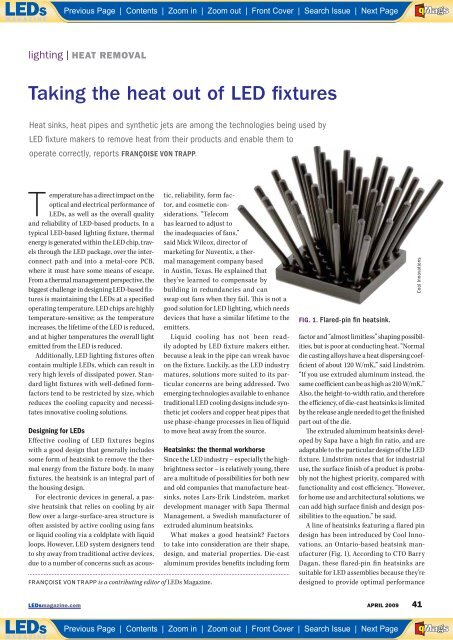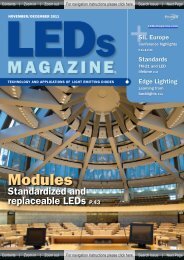Zoom In - Beriled
Zoom In - Beriled
Zoom In - Beriled
- No tags were found...
You also want an ePaper? Increase the reach of your titles
YUMPU automatically turns print PDFs into web optimized ePapers that Google loves.
Previous Page | Contents | <strong>Zoom</strong> in | <strong>Zoom</strong> out | Front Cover | Search Issue | Next PageABE FMaGSlighting | HEAT REMOVALTaking the heat out of LED fixturesHeat sinks, heat pipes and synthetic jets are among the technologies being used byLED fi xture makers to remove heat from their products and enable them tooperate correctly, reports FRANÇOISE VON TRAPP.Temperature has a direct impact on theoptical and electrical performance ofLEDs, as well as the overall qualityand reliability of LED-based products. <strong>In</strong> atypical LED-based lighting fixture, thermalenergy is generated within the LED chip, travelsthrough the LED package, over the interconnectpath and into a metal-core PCB,where it must have some means of escape.From a thermal management perspective, thebiggest challenge in designing LED-based fixturesis maintaining the LEDs at a specifiedoperating temperature. LED chips are highlytemperature-sensitive; as the temperatureincreases, the lifetime of the LED is reduced,and at higher temperatures the overall lightemitted from the LED is reduced.Additionally, LED lighting fixtures oftencontain multiple LEDs, which can result invery high levels of dissipated power. Standardlight fixtures with well-defined formfactorstend to be restricted by size, whichreduces the cooling capacity and necessitatesinnovative cooling solutions.FRANÇOISE VON TRAPP is a contributing editor of LEDs Magazine.Designing for LEDsEffective cooling of LED fixtures beginswith a good design that generally includessome form of heatsink to remove the thermalenergy from the fixture body. <strong>In</strong> manyfixtures, the heatsink is an integral part ofthe housing design.For electronic devices in general, a passiveheatsink that relies on cooling by airflow over a large-surface-area structure isoften assisted by active cooling using fansor liquid cooling via a coldplate with liquidloops. However, LED system designers tendto shy away from traditional active devices,due to a number of concerns such as acoustic,reliability, form factor,and cosmetic considerations.“Telecomhas learned to adjust tothe inadequacies of fans,”said Mick Wilcox, director ofmarketing for Nuventix, a thermalmanagement company basedin Austin, Texas. He explained thatthey’ve learned to compensate bybuilding in redundancies and canswap out fans when they fail. This is not agood solution for LED lighting, which needsdevices that have a similar lifetime to theemitters.Liquid cooling has not been readilyadopted by LED fixture makers either,because a leak in the pipe can wreak havocon the fixture. Luckily, as the LED industrymatures, solutions more suited to its particularconcerns are being addressed. Twoemerging technologies available to enhancetraditional LED cooling designs include syntheticjet coolers and copper heat pipes thatuse phase-change processes in lieu of liquidto move heat away from the source.Heatsinks: the thermal workhorseSince the LED industry – especially the highbrightnesssector – is relatively young, thereare a multitude of possibilities for both newand old companies that manufacture heatsinks,notes Lars-Erik Lindström, marketdevelopment manager with Sapa ThermalManagement, a Swedish manufacturer ofextruded aluminum heatsinks.What makes a good heatsink? Factorsto take into consideration are their shape,design, and material properties. Die-castaluminum provides benefits including formFIG. 1. Flared-pin fi n heatsink.Cool <strong>In</strong>novationsfactor and “almost limitless” shaping possibilities,but is poor at conducting heat. “Normaldie casting alloys have a heat dispersing coefficientof about 120 W/mK,” said Lindström.“If you use extruded aluminum instead, thesame coefficient can be as high as 210 W/mK.”Also, the height-to-width ratio, and thereforethe efficiency, of die-cast heatsinks is limitedby the release angle needed to get the finishedpart out of the die.The extruded aluminum heatsinks developedby Sapa have a high fin ratio, and areadaptable to the particular design of the LEDfixture. Lindström notes that for industrialuse, the surface finish of a product is probablynot the highest priority, compared withfunctionality and cost efficiency. “However,for home use and architectural solutions, wecan add high surface finish and design possibilitiesto the equation,” he said.A line of heatsinks featuring a flared pindesign has been introduced by Cool <strong>In</strong>novations,an Ontario-based heatsink manufacturer(Fig. 1). According to CTO BarryDagan, these flared-pin fin heatsinks aresuitable for LED assemblies because they'redesigned to provide optimal performanceLEDsmagazine.com APRIL 2009 41Previous Page | Contents | <strong>Zoom</strong> in | <strong>Zoom</strong> out | Front Cover | Search Issue | Next PageABE FMaGS

















